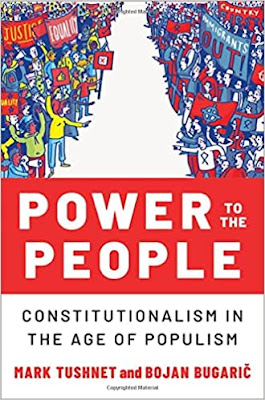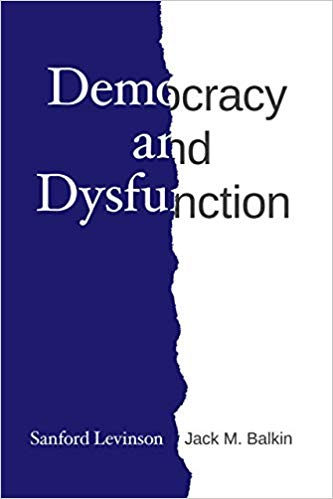Balkinization
an unanticipated consequence of
Jack M. Balkin
Balkinization Symposiums: A Continuing List
E-mail:
Jack Balkin:
jackbalkin at yahoo.com
Bruce Ackerman
bruce.ackerman at yale.edu
Ian Ayres
ian.ayres at yale.edu
Corey Brettschneider
corey_brettschneider at brown.edu
Mary Dudziak
mary.l.dudziak at emory.edu
Joey Fishkin
joey.fishkin at gmail.com
Heather Gerken heather.gerken at yale.edu
Abbe Gluck abbe.gluck at yale.edu
Mark Graber
mgraber at law.umaryland.edu
Stephen Griffin
sgriffin at tulane.edu
Jonathan Hafetz
jonathan.hafetz at shu.edu
Jeremy Kessler
jkessler at law.columbia.edu
Andrew Koppelman
akoppelman at law.northwestern.edu
Marty Lederman
msl46 at law.georgetown.edu
Sanford Levinson
slevinson at law.utexas.edu
David Luban
david.luban at gmail.com
Gerard Magliocca
gmaglioc at iupui.edu
Jason Mazzone
mazzonej at illinois.edu
Linda McClain
lmcclain at bu.edu
John Mikhail
mikhail at law.georgetown.edu
Frank Pasquale
pasquale.frank at gmail.com
Nate Persily
npersily at gmail.com
Michael Stokes Paulsen
michaelstokespaulsen at gmail.com
Deborah Pearlstein
dpearlst at yu.edu
Rick Pildes
rick.pildes at nyu.edu
David Pozen
dpozen at law.columbia.edu
Richard Primus
raprimus at umich.edu
K. Sabeel Rahmansabeel.rahman at brooklaw.edu
Alice Ristroph
alice.ristroph at shu.edu
Neil Siegel
siegel at law.duke.edu
David Super
david.super at law.georgetown.edu
Brian Tamanaha
btamanaha at wulaw.wustl.edu
Nelson Tebbe
nelson.tebbe at brooklaw.edu
Mark Tushnet
mtushnet at law.harvard.edu
Adam Winkler
winkler at ucla.edu
Compendium of posts on Hobby Lobby and related cases
The Anti-Torture Memos: Balkinization Posts on Torture, Interrogation, Detention, War Powers, and OLC
The Anti-Torture Memos (arranged by topic)
Recent Posts
The Struggle to Institutionalise Impermissibility
Just A Few Blogs
ACS Blog
Alas, a Blog
Althouse
Arts and Letters Daily
Atrios (Eschaton)
Bill of Health
Buzzflash.com
Buzz Machine
Cato at Liberty
Juan Cole (Informed Comment)
Concurring Opinions
The Constitution in 2020
Corrente
Crooked Timber
Daily Howler
Daily Kos
Dana Boyd
Brad DeLong
Digby (Hullabaloo)
Discriminations
Daniel Drezner
Kevin Drum (Mother Jones)
Electrolite
En Banc
Eunomia (Daniel Larison)
Fafblog
Michael Froomkin (Discourse.net)
GovLab (Beth Noveck)
Rick Hasen (Election Law)
History News Network
How Appealing
Ignatz (Sam Heldman)
The Importance of (Ernie Miller)
Infolaw
Instapundit
International Economic Law and Policy Blog
IntLawGrrls
Jacob Levy
Jesus' General
Jurisdynamics
The Kitchen Cabinet
Mark Kleiman
Law Blog Central
Larry Lessig
Lawyers, Guns and Money
Liberal Oasis
Brian Leiter's Law School Reports
The Leiter Reports
Marginal Revolution
Megan McArdle
Memeorandum
Metafilter
Mirror of Justice
The New Republic
Newseum
No More Mister Nice Blog
Brendan Nyhan
Opinio Juris
Orcinus
The Originalism Blog
Pandagon
Passport (Foreign Policy)
Overcoming Bias
Political Animal (Washington Monthly)
Political Theory Daily Review
Political Wire (Taegan Goddard)
The Poor Man
Virginia Postrel
Prawfsblawg
Public Reason
Jonathan Rauch
Raw Story
Redstate
ReligiousLeftLaw.com
Reporters Committee For Freedom of the Press
Reproductive Rights Blog
Rothman's Roadmap to the Right of Publicity
SCOTUS Blog
Seeing the Forest
Clay Shirky
The Shifted Librarian
The Situationist
Larry Solum (Legal Theory)
Andrew Sullivan
Talking Points Memo
Talk Left
Tapped
Tbogg
TechPresident
The Paper Chase (Jurist)
Tom Paine
Tom Tomorrow (This Modern World)
Eve Tushnet
Uggabugga
University of Chicago Law School Faculty Blog
Unqualified Offerings
The Volokh Conspiracy
War and Piece (Laura Rozen)
Wampum
Oliver Willis
Wonkette
Written Description
Matthew Yglesias
Yin
Your Choice of Feeds
1. XML
powered by
2. Atom Feed
3. RSS 2.0
Tuesday, November 11, 2025
The Struggle to Institutionalise Impermissibility
Guest Blogger
For the Balkinization symposium on Judith Resnik, Impermissible Punishments: How Prison Became a Problem for Democracy (University of Chicago Press, 2025). Nicola Lacey
Judith Resnik’s magisterial
and comprehensive survey of the history of punishment within prisons, and of
the struggle to subject these practices to critical scrutiny, constitutional
limits and progressive reform, inspires, first and foremost, humility in the
face of a considerable scholarly achievement.
But, as Resnik herself would, I take it, both agree and indeed hope, it
also inspires perplexity. After so much
effort, over three centuries, on the part of so many actors – ‘pioneering
prisoners’ [1]
as well as campaigning reformers, national and international organisations, courts
and law-making bodies – how can it be that the persistent effort to build
consensus around norms of impermissibility, and to institutionalise those
norms, has had such limited success?
Notwithstanding the fact that reform efforts have increasingly taken
place in a broad international context which affirms the values of equal respect
and human dignity in punishment, the prison seems relatively impervious to
decisive humanisation. As Resnik argues,
all too often it remains a place of ‘ruination’: a space in which the basics of
human dignity and even of personal safety, let alone of civic status, are either
absent or actively subverted by the conditions of imprisonment. Moreover this holds true not only for
authoritarian systems but also the avowedly liberal democracies which most
loudly affirm their adherence to humane and civilised norms of governance. And in this respect, the United States
provides perhaps the most perplexing case of all. Thanks to the efforts of
many scholars across the world,[2] we now understand a great
deal about the features of prison regimes, prisoner-prison staff interactions,
and prison architecture which undermine or facilitate (relative) humanity in
punishment. Many prisons in Northern
Europe, and in the Nordic countries in particular, exemplify the effort to make
the experience of imprisonment as close to normal civic life as is consistent
with its penal function.[3] But we also know that embedding pro-humanity
norms and arrangements within an institution which is by definition in the
business of coercion and of punishing offenders, even if the prison sentence is
seen as being ‘as’ rather than ‘for’ punishment, requires constant effort,
commitment, and investment in infrastructure and human resources. And here lies the core difficulty. While we have a good sense of what a humane –
or at least less inhumane - prison would look like, we have a much weaker grasp
of how to build political coalitions stable enough to support the long term
investment needed; and in many countries, the public attitudes which would be
needed to stabilise politicians’ commitments to humanity in punishment are yet
more elusive.
There is much debate about
just how far the general trend towards greater public ‘punitiveness’ since the
1970s in many countries, and in the United States in particular, was caused by
rising crime: what is beyond doubt, however, is that the intensified volume of
law and order politics has not happened in a political vacuum; it has both fed
and been shaped by public attitudes which render a reputation for leniency in
punishment a political liability.[4] Of course, robust criminal justice policy
does not necessarily equate to Resnik’s ‘impermissible punishments’. But wherever it flows from the demonisation
of offenders as other, dangerous, undeserving, it surely makes them more
likely. This implies that what Robert
Sampson has called the ‘characterological’ framework of much contemporary
criminology and crime control policy is itself problematic.[5] Populist punitiveness and
the resurgence of an implicit framing conception of crime as a product of bad
character are therefore undoubtedly part of the problem in any effort to
institutionalise norms of impermissibility.
For this depends on motivating a sense of baseline solidarity, or at
least acknowledgment of an ongoing relationship as co-inhabitants of a society
which – contrary to the impression created by the ‘lock them up and throw away
the key’ tone of much public debate – almost all of them will re-enter, most of
them sooner rather than later. This is just one of the many ways in which the
interdependency between those within the outside the prison, which Resnik
emphasises makes itself felt. So how might a polity
foster the sort of attitudes which might underpin a more temperate debate about
the social problems of crime and how to respond to it? How can a system create barriers to opportunistic
politicians who see adding fuel to the flames of a divisive and demonising
debate about crime and punishment as a means to electoral success? In this respect, I continue
to think that building a comparative perspective into our scholarship is a key
resource. This is not, pace Resnik,[6] a matter of ‘national
character’; rather, it is an effort to grasp how distinctive institutional
arrangements can foster (or undermine) the social and political capacities
needed to institutionalise norms of impermissibility.[7] These arrangements in my view include not
only the interlocking institutional structures of the political system – party
structure, the electoral system, the distribution of veto points, opportunities
for participation; of the labour market and its production regime; and of the
welfare state. It also includes factors
like the culture and regulatory framework of news media and the structure of
the professional bureaucracy.
Unfortunately, these institutional features tend to interlock in ways
which make the alluring prospect of comparison-inspired policy and
institutional transplants fraught with difficulty. But an understanding of how these aspects of
political and economic structure shape the development of penal policy, not
least by supporting or undermining the sense of collective interdependency,
solidarity and belonging – or to put it in the terms favoured by economists and
evolutionary psychologists, high expected associational value – is an important
first step to working out what is (and
is not) possible in any particular context.
Crucially, at this dismal moment in history, it reminds us that
uncontrolled impermissibility in punishment is contingent: things could be
otherwise, as they have been in other times, and are in other places. So even in the light of the record charted in
Resnik’s impressive book, a comparative perspective gives a glimmer of hope. Nicola Lacey is School Professor of
Law, Gender and Social Policy at LSE Law School; you can reach her on
n.m.lacey@lse.ac.uk. [1] Resnik 611 [2] Ibid; see also Alison Liebling, Aristotle’s
Prison (OUP forthcoming); Yvonne Jewkes, An Architecture of Hope (Scribe 2024); Sharon Shalev, Supermax: Controlling Risk Through Solitary
Confinement (Routledge 2010); Elaine
Genders and Elaine Player,Grendon: A
Study of a Therapeutic Prison (OUP 1995) [3] John Pratt and Anna Eriksson, Contrasts
in Punishment: An explanation of Anglophone excess and Nordic exceptionalism (Routledge
2013). [4] Peter K. Enns, Incarceration
Nation (Cambridge University Press 2016). [5] Robert J. Sampson and L. Ash Smith, Rethinking Criminal Propensity
and Character’ 50 Crime and Justice (2021);
Nicola Lacey, ‘The Resurgence of
Character’, in Antony Duff and Stuart Green (eds.) Philosophical Foundations of Criminal Law (2011) [6] Resnik 609 [7] Nicola
Lacey, The Prisoners Dilemma
(Cambridge University Press 20078); Nicola Lacey, David Soskice and David Hope,
‘Understanding the Determinants of Penal Policy’ (2018) Annual Review of Criminology 195-217; Nicola Lacey and Hanna
Pickard, ‘The Chimera of Proportionality: Institutionalising Limits on
Punishment in Contemporary Social and Political Systems’ 80 Modern Law Review 216 (2015); Nicola Lacey,
‘Beyond Harsh Justice: a space for institutional reconstruction’ (2024) 35(3) Yale Journal of Law and the
Humanities 518-536
Posted
9:30 AM
by Guest Blogger [link]
Books by Balkinization Bloggers

Linda C. McClain and Aziza Ahmed, The Routledge Companion to Gender and COVID-19 (Routledge, 2024)

David Pozen, The Constitution of the War on Drugs (Oxford University Press, 2024)

Jack M. Balkin, Memory and Authority: The Uses of History in Constitutional Interpretation (Yale University Press, 2024)

Mark A. Graber, Punish Treason, Reward Loyalty: The Forgotten Goals of Constitutional Reform after the Civil War (University of Kansas Press, 2023)

Jack M. Balkin, What Roe v. Wade Should Have Said: The Nation's Top Legal Experts Rewrite America's Most Controversial Decision - Revised Edition (NYU Press, 2023)

Andrew Koppelman, Burning Down the House: How Libertarian Philosophy Was Corrupted by Delusion and Greed (St. Martin’s Press, 2022)

Gerard N. Magliocca, Washington's Heir: The Life of Justice Bushrod Washington (Oxford University Press, 2022)

Joseph Fishkin and William E. Forbath, The Anti-Oligarchy Constitution: Reconstructing the Economic Foundations of American Democracy (Harvard University Press, 2022)

Mark Tushnet and Bojan Bugaric, Power to the People: Constitutionalism in the Age of Populism (Oxford University Press 2021).

Mark Philip Bradley and Mary L. Dudziak, eds., Making the Forever War: Marilyn B. Young on the Culture and Politics of American Militarism Culture and Politics in the Cold War and Beyond (University of Massachusetts Press, 2021).

Jack M. Balkin, What Obergefell v. Hodges Should Have Said: The Nation's Top Legal Experts Rewrite America's Same-Sex Marriage Decision (Yale University Press, 2020)

Frank Pasquale, New Laws of Robotics: Defending Human Expertise in the Age of AI (Belknap Press, 2020)

Jack M. Balkin, The Cycles of Constitutional Time (Oxford University Press, 2020)

Mark Tushnet, Taking Back the Constitution: Activist Judges and the Next Age of American Law (Yale University Press 2020).

Andrew Koppelman, Gay Rights vs. Religious Liberty?: The Unnecessary Conflict (Oxford University Press, 2020)

Ezekiel J Emanuel and Abbe R. Gluck, The Trillion Dollar Revolution: How the Affordable Care Act Transformed Politics, Law, and Health Care in America (PublicAffairs, 2020)

Linda C. McClain, Who's the Bigot?: Learning from Conflicts over Marriage and Civil Rights Law (Oxford University Press, 2020)

Sanford Levinson and Jack M. Balkin, Democracy and Dysfunction (University of Chicago Press, 2019)

Sanford Levinson, Written in Stone: Public Monuments in Changing Societies (Duke University Press 2018)

Mark A. Graber, Sanford Levinson, and Mark Tushnet, eds., Constitutional Democracy in Crisis? (Oxford University Press 2018)

Gerard Magliocca, The Heart of the Constitution: How the Bill of Rights became the Bill of Rights (Oxford University Press, 2018)

Cynthia Levinson and Sanford Levinson, Fault Lines in the Constitution: The Framers, Their Fights, and the Flaws that Affect Us Today (Peachtree Publishers, 2017)

Brian Z. Tamanaha, A Realistic Theory of Law (Cambridge University Press 2017)

Sanford Levinson, Nullification and Secession in Modern Constitutional Thought (University Press of Kansas 2016)

Sanford Levinson, An Argument Open to All: Reading The Federalist in the 21st Century (Yale University Press 2015)

Stephen M. Griffin, Broken Trust: Dysfunctional Government and Constitutional Reform (University Press of Kansas, 2015)

Frank Pasquale, The Black Box Society: The Secret Algorithms That Control Money and Information (Harvard University Press, 2015)

Bruce Ackerman, We the People, Volume 3: The Civil Rights Revolution (Harvard University Press, 2014)
Balkinization Symposium on We the People, Volume 3: The Civil Rights Revolution

Joseph Fishkin, Bottlenecks: A New Theory of Equal Opportunity (Oxford University Press, 2014)

Mark A. Graber, A New Introduction to American Constitutionalism (Oxford University Press, 2013)

John Mikhail, Elements of Moral Cognition: Rawls' Linguistic Analogy and the Cognitive Science of Moral and Legal Judgment (Cambridge University Press, 2013)

Gerard N. Magliocca, American Founding Son: John Bingham and the Invention of the Fourteenth Amendment (New York University Press, 2013)

Stephen M. Griffin, Long Wars and the Constitution (Harvard University Press, 2013)

Andrew Koppelman, The Tough Luck Constitution and the Assault on Health Care Reform (Oxford University Press, 2013)

James E. Fleming and Linda C. McClain, Ordered Liberty: Rights, Responsibilities, and Virtues (Harvard University Press, 2013)
Balkinization Symposium on Ordered Liberty: Rights, Responsibilities, and Virtues

Andrew Koppelman, Defending American Religious Neutrality (Harvard University Press, 2013)

Brian Z. Tamanaha, Failing Law Schools (University of Chicago Press, 2012)

Sanford Levinson, Framed: America's 51 Constitutions and the Crisis of Governance (Oxford University Press, 2012)

Linda C. McClain and Joanna L. Grossman, Gender Equality: Dimensions of Women's Equal Citizenship (Cambridge University Press, 2012)

Mary Dudziak, War Time: An Idea, Its History, Its Consequences (Oxford University Press, 2012)

Jack M. Balkin, Living Originalism (Harvard University Press, 2011)

Jason Mazzone, Copyfraud and Other Abuses of Intellectual Property Law (Stanford University Press, 2011)

Richard W. Garnett and Andrew Koppelman, First Amendment Stories, (Foundation Press 2011)

Jack M. Balkin, Constitutional Redemption: Political Faith in an Unjust World (Harvard University Press, 2011)

Gerard Magliocca, The Tragedy of William Jennings Bryan: Constitutional Law and the Politics of Backlash (Yale University Press, 2011)

Bernard Harcourt, The Illusion of Free Markets: Punishment and the Myth of Natural Order (Harvard University Press, 2010)

Bruce Ackerman, The Decline and Fall of the American Republic (Harvard University Press, 2010)
Balkinization Symposium on The Decline and Fall of the American Republic

Ian Ayres. Carrots and Sticks: Unlock the Power of Incentives to Get Things Done (Bantam Books, 2010)

Mark Tushnet, Why the Constitution Matters (Yale University Press 2010)
Ian Ayres and Barry Nalebuff: Lifecycle Investing: A New, Safe, and Audacious Way to Improve the Performance of Your Retirement Portfolio (Basic Books, 2010)
.jpg)
Jack M. Balkin, The Laws of Change: I Ching and the Philosophy of Life (2d Edition, Sybil Creek Press 2009)

Brian Z. Tamanaha, Beyond the Formalist-Realist Divide: The Role of Politics in Judging (Princeton University Press 2009)

Andrew Koppelman and Tobias Barrington Wolff, A Right to Discriminate?: How the Case of Boy Scouts of America v. James Dale Warped the Law of Free Association (Yale University Press 2009)

Jack M. Balkin and Reva B. Siegel, The Constitution in 2020 (Oxford University Press 2009)
Heather K. Gerken, The Democracy Index: Why Our Election System Is Failing and How to Fix It (Princeton University Press 2009)

Mary Dudziak, Exporting American Dreams: Thurgood Marshall's African Journey (Oxford University Press 2008)

David Luban, Legal Ethics and Human Dignity (Cambridge Univ. Press 2007)

Ian Ayres, Super Crunchers: Why Thinking-By-Numbers is the New Way to be Smart (Bantam 2007)

Jack M. Balkin, James Grimmelmann, Eddan Katz, Nimrod Kozlovski, Shlomit Wagman and Tal Zarsky, eds., Cybercrime: Digital Cops in a Networked Environment (N.Y.U. Press 2007)

Jack M. Balkin and Beth Simone Noveck, The State of Play: Law, Games, and Virtual Worlds (N.Y.U. Press 2006)

Andrew Koppelman, Same Sex, Different States: When Same-Sex Marriages Cross State Lines (Yale University Press 2006)
Brian Tamanaha, Law as a Means to an End (Cambridge University Press 2006)
Sanford Levinson, Our Undemocratic Constitution (Oxford University Press 2006)
Mark Graber, Dred Scott and the Problem of Constitutional Evil (Cambridge University Press 2006)
Jack M. Balkin, ed., What Roe v. Wade Should Have Said (N.Y.U. Press 2005)
Sanford Levinson, ed., Torture: A Collection (Oxford University Press 2004)
Balkin.com homepage
Bibliography
Conlaw.net
Cultural Software
Writings
Opeds
The Information Society Project
BrownvBoard.com
Useful Links
Syllabi and Exams